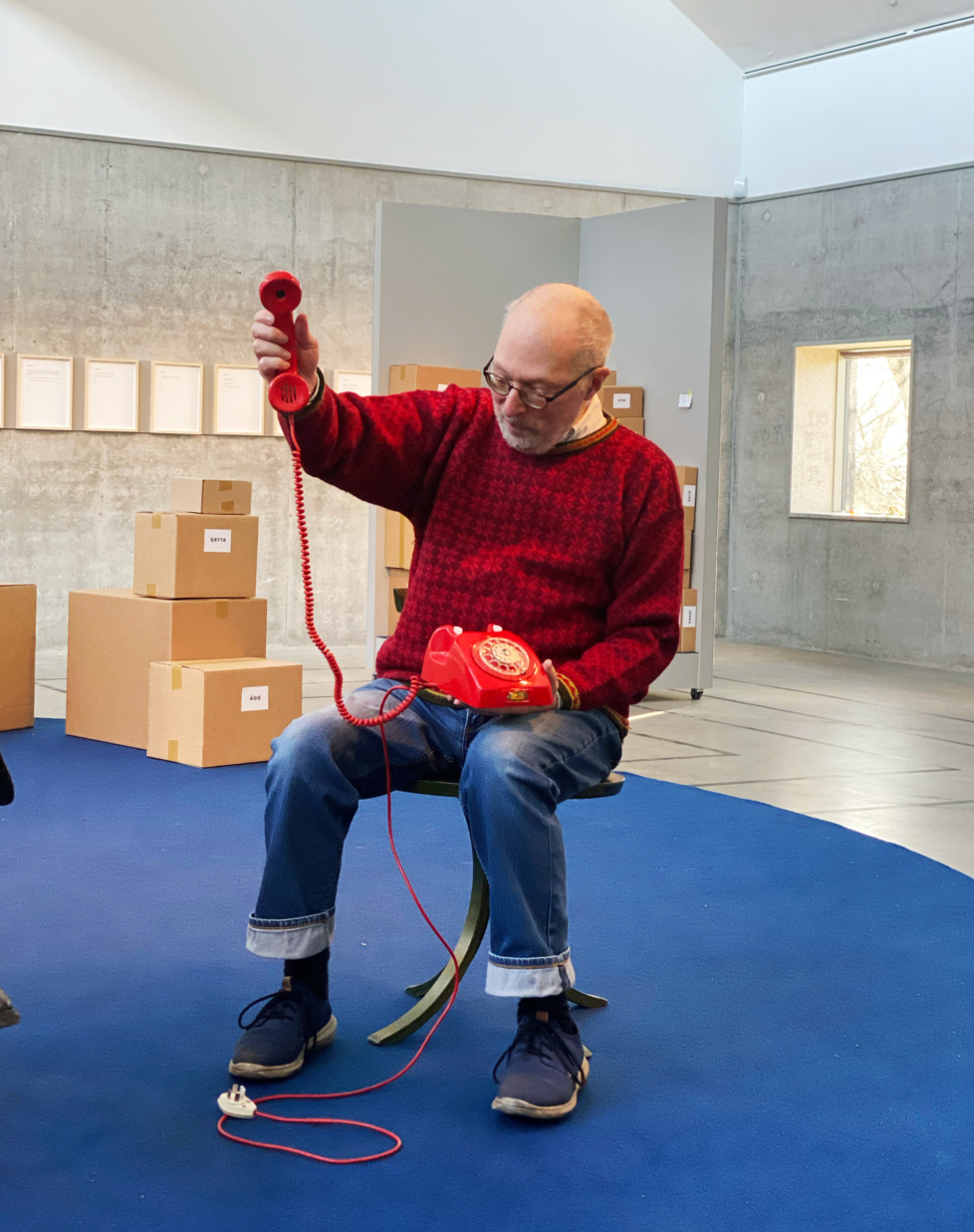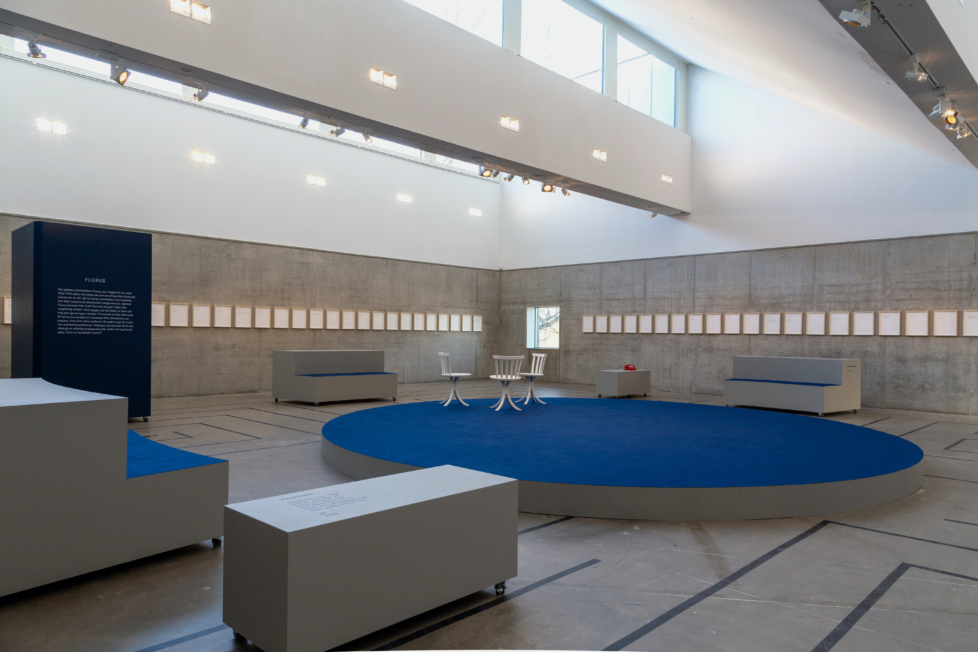
The news of an upcoming exhibition of American artist Ken Friedman in Kalmar, a city of some forty thousand people in southeastern Sweden, must have raised an eyebrow or two. Friedman is something of a legend in the Fluxus movement, but in recent decades he has primarily devoted his time to academia as a professor of strategic design at the Norwegian School of Management in Oslo, and later as dean of the faculty of design at Swinburne University of Technology in Melbourne. Today, he is a professor at Tongji University, Shanghai, and a resident of Kalmar where he, unbeknown to many, has been living since 2014.
The exhibition 92 Events opens tomorrow, Wednesday 7 February, at Kalmar Art Museum, and spans six decades of artistic activity. In addition to the event scores themselves, Friedman’s work will be activated both through performances and a unique set design developed in collaboration with Museum Director Bettina Perhsson and set designer Camilla Ed.
A clear example of the performative function of language in Friedman’s work is his 1971 event score Distant, which reads: “The distance from this sentence to your eye is my sculpture.” Friedman joined Fluxus in 1966, collaborating with George Maciunas, Nam June Paik, and John Cage, among others. During the early 1970s, he served as the director of Dick Higgins’s Something Else Press, a prominent publisher of Fluxus-related books, pamphlets, and concrete poetry. Friedman has also worked as a Fluxus historian and archivist, and edited the book The Fluxus Reader (1998).
I spoke with Friedman ahead of tomorrow’s opening.
*
Ken, your exhibition 92 Events opens at Kalmar Art Museum tomorrow. Could you say something about the preparations for the show? What is the audience about to see, read, discover, and participate in?
Most museums show the event scores as words printed on paper. That’s how I designed the first version of the exhibition in 1973, and that is how different venues have exhibited it in the years since then. Now, Kalmar Art Museum will activate the show by inviting people to make the events their own. This is in keeping with the Fluxus spirit. What’s different here is that viewers will not simply read the event scores on the wall or on a card. Different artists will interpret the events, each in their own way, and the museum will present their interpretations along with my scores.
This way of realising the show was developed by the director, Bettina Pehrsson. It’s the first time any museum has realised a series of Fluxconcerts with an intermedia perspective, in which different artists present the same works in several concerts.
Also, the installation in Kalmar will be unique. In addition to the scores mounted on the walls, the way they have always been shown, the exhibition designer Camilla Ed has realised a creative and energetic room. There will be places to sit during concerts. You will be able to read, listen, look, and sometimes play with artefacts. There will be walls and niches that move during concerts. She has also realised several scores in architectural form. This creates depth in the room, and layers of experience.
This will allow each viewer to take a physical part in the exhibition along with an intellectual part. For me, this engages the hermeneutic dimensions of my work and the hermeneutic tradition of Fluxus. Depending on what each viewer brings to the exhibition, the hermeneutical horizon will unfold and come to life in a personal way. To some degree, this is true of all art, but Camilla will bring the visitor’s body into the body of the exhibition. She has created something unique.

You’ve lived in Kalmar since 2014. How did you end up there? Will the fact that you live in Kalmar inform the exhibition somehow?
My wife Ditte lived here when she was young. We often visited her family, and I came to love the city. After living in Melbourne, Australia, for many years, we decided it was time to come back to Sweden. Kalmar is a small city, about the same size as New London, Connecticut, the city where I was born and did my first events. We have the same sort of parks and gardens. We have historical cemeteries and old buildings with culture and tradition. In New London, I had the Atlantic. In Kalmar, I have the Baltic.
My location will not inform the exhibition per se. But context is always important. The context is that I live a five-minute walk from the museum. The museum has become a hub for the exhibition. For most museums, it’s the art. Here, it’s personal.
I have a direct relationship with the museum people. I can see how they work. They invite me over to watch the installation evolve and we have an ongoing conversation as the show develops. People from Kalmar are developing the concerts and performances. We’re all engaged in an ongoing conversation.
When I think about it, this personal engagement is as unique as the installation.
Your work is primarily language-based, and the exhibition’s title signals the relation between text and the performative. What is the status of the written word in your work?
Events function in four ways. First, there is an idea. Second, there is a score. Third, there is a physical realisation or performance of the score. Fourth, many events leave artefacts or relics behind.
I’ve realised the events in many different media, and language is always an important component. Language gives shape to our internal world. And language is the tool that we use to understand the world around us. It’s the bedrock of ideas. The written text communicates ideas, but someone with a good memory doesn’t need a written text. Anyone who can read these scores and remember them can own the entire show. It’s up to anyone who wants to realise or use these scores, each in their own way.
An art that begins in language also takes shape in time as narrative and memory. It has a beginning, a middle, and an end. When you read the beginning of an event score, you can look forward to the end. From the end, you look back at the beginning. Each event is a small story taking place in life. For me, events are fragments of reality. I build these fragments out of words. In a way, it becomes an archeology of life.

Your engagement with Fluxus started at an early age. You joined in 1966 as the youngest member and affiliate. You’ve worked closely with George Maciunas and Nam June Paik, among others. Where do you see your current work in relation to the legacy of this history, its variegated narrations and narratives?
The great Fluxus collector Jean Brown was a friend of Marcel Duchamp. When people would ask Duchamp about history, she said his usual answer was: “Posterity will be the judge.” That’s as good an answer as any.
How has your own relation to Fluxus changed over the years?
I’m 73 now. I’ve been involved with Fluxus and the work of my Fluxus colleagues for nearly six decades. I hope that I’ve changed. Change is the condition of development.
Even though I had other plans in the 1960s and 1970s, I came to live a great part of my life in the art world. In the 1980s, I lived in New York. I could walk around the corner to see Christo and Jeanne-Claude. I’d meet [gallerist] Emily Harvey for breakfast on most mornings. Dick Higgins and I would meet for dim sum in Chinatown. I’d run into Nam June Paik on the street. It wasn’t all of the art world, but it was the part of the art world where I felt at home, and I saw people I loved on a regular basis.
When I moved to Norway in the 1990s, my life changed. I took up a professorship and moved into a life of research. I was a professor at a management school in Oslo. Research and teaching took most of my time and energy. I was not part of the art world in Norway, and, later, I wasn’t part of the art world in Australia, either.
During those years, my art had a life of its own. Curators and art historians began to write about me, but I was living another reality. In those years, it was as though I was looking back at the life of someone else who had made those works and done those things. When I went to places where people knew about art, they would occasionally ask: “Are you related to the Fluxus artist Ken Friedman?” Rather than explain that it was me after all that time, I finally began to answer: “No, but I met him once.”
In the last few years, I’ve begun to work with art again. It’s not so much a new relationship with Fluxus as it is a new relationship with myself.
Finally, what do you look forward to the most with this exhibition, considering its performative nature?
I’m eager to see what different artists, musicians, and dancers do with the events.

